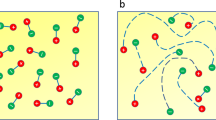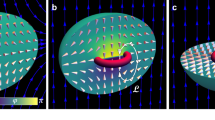Abstract
Magnetic monopoles—particles that behave as isolated north or south magnetic poles—have been the subject of speculation since the first detailed observations of magnetism several hundred years ago1. Numerous theoretical investigations and hitherto unsuccessful experimental searches2 have followed Dirac’s 1931 development of a theory of monopoles consistent with both quantum mechanics and the gauge invariance of the electromagnetic field3. The existence of even a single Dirac magnetic monopole would have far-reaching physical consequences, most famously explaining the quantization of electric charge3,4. Although analogues of magnetic monopoles have been found in exotic spin ices5,6 and other systems7,8,9, there has been no direct experimental observation of Dirac monopoles within a medium described by a quantum field, such as superfluid helium-3 (refs 10, 11, 12, 13). Here we demonstrate the controlled creation14 of Dirac monopoles in the synthetic magnetic field produced by a spinor Bose–Einstein condensate. Monopoles are identified, in both experiments and matching numerical simulations, at the termini of vortex lines within the condensate. By directly imaging such a vortex line, the presence of a monopole may be discerned from the experimental data alone. These real-space images provide conclusive and long-awaited experimental evidence of the existence of Dirac monopoles. Our result provides an unprecedented opportunity to observe and manipulate these quantum mechanical entities in a controlled environment.
This is a preview of subscription content, access via your institution
Access options
Subscribe to this journal
Receive 51 print issues and online access
$199.00 per year
only $3.90 per issue
Buy this article
- Purchase on Springer Link
- Instant access to full article PDF
Prices may be subject to local taxes which are calculated during checkout




Similar content being viewed by others
References
Goldhaber A. S., Trower W. P., eds. Magnetic Monopoles (American Association of Physics Teachers, 1990)
Milton, K. A. Theoretical and experimental status of magnetic monopoles. Rep. Prog. Phys. 69, 1637–1711 (2006)
Dirac, P. A. M. Quantised singularities in the electromagnetic field. Proc. R. Soc. Lond. A 133, 60–72 (1931)
Vilenkin A., Shellard E. P. S., eds. Cosmic Strings and Other Topological Defects (Cambridge Univ. Press, 1994)
Castelnovo, C., Moessner, R. & Sondhi, S. L. Magnetic monopoles in spin ice. Nature 451, 42–45 (2008)
Morris, D. J. P. et al. Dirac strings and magnetic monopoles in the spin ice Dy2Ti2O7 . Science 326, 411–414 (2009)
Chuang, I., Durrer, R., Turok, N. & Yurke, B. Cosmology in the laboratory: defect dynamics in liquid crystals. Science 251, 1336–1342 (1991)
Fang, Z. et al. The anomalous Hall effect and magnetic monopoles in momentum space. Science 302, 92–95 (2003)
Milde, P. et al. Unwinding of a skyrmion lattice by magnetic monopoles. Science 340, 1076–1080 (2013)
Blaha, S. Quantization rules for point singularities in superfluid 3He and liquid crystals. Phys. Rev. Lett. 36, 874–876 (1976)
Volovik, G. & Mineev, V. P. Vortices with free ends in superfluid He3-A. JETP Lett. 23, 647–649 (1976)
Salomaa, M. M. Monopoles in the rotating superfluid helium-3 A–B interface. Nature 326, 367–370 (1987)
Volovik, G. The Universe in a Helium Droplet 214–217 (Oxford Univ. Press, 2003)
Pietilä, V. & Möttönen, M. Creation of Dirac monopoles in spinor Bose-Einstein condensates. Phys. Rev. Lett. 103, 030401 (2009)
Lin, Y.-J., Compton, R. L., Jiménez-Garcia, K., Porto, J. V. & Spielman, I. B. Synthetic magnetic fields for ultracold neutral atoms. Nature 462, 628–631 (2009)
Dalibard, J., Gerbier, F., Juzeliūnas, G. & Öhberg, P. Artificial gauge potentials for neutral atoms. Rev. Mod. Phys. 83, 1523–1543 (2011)
Savage, C. M. & Ruostekoski, J. Dirac monopoles and dipoles in ferromagnetic spinor Bose-Einstein condensates. Phys. Rev. A 68, 043604 (2003)
Leanhardt, A. E. et al. Imprinting vortices in a Bose-Einstein condensate using topological phases. Phys. Rev. Lett. 89, 190403 (2002)
Choi, J.-y., Kwon, W. J. & Shin, Y.-i. Observation of topologically stable 2D skyrmions in an antiferromagnetic spinor Bose-Einstein condensate. Phys. Rev. Lett. 108, 035301 (2012)
Wu, T. T. & Yang, C. N. Concept of nonintegrable phase factors and global formulation of gauge fields. Phys. Rev. D 12, 3845–3857 (1975)
Kaufman, A. M. et al. Radio-frequency dressing of multiple Feshbach resonances. Phys. Rev. A 80, 050701 (2009)
Shin, Y. et al. Dynamical instability of a doubly quantized vortex in a Bose-Einstein condensate. Phys. Rev. Lett. 93, 160406 (2004)
Cabrera, B. First results from a superconductive detector for moving magnetic monopoles. Phys. Rev. Lett. 48, 1378–1381 (1982)
Ruokokoski, E., Pietilä, V. & Möttönen, M. Ground-state Dirac monopole. Phys. Rev. A 84, 063627 (2011)
Pietilä, V. & Möttönen, M. Non-Abelian magnetic monopole in a Bose-Einstein condensate. Phys. Rev. Lett. 102, 080403 (2009)
Möttönen, M., Pietilä, V. & Virtanen, S. M. M. Vortex pump for dilute Bose-Einstein condensates. Phys. Rev. Lett. 99, 250406 (2007)
Roncaglia, M., Rizzi, M. & Dalibard, J. From rotating atomic rings to quantum Hall states. Sci. Rep. 1, 43 (2011)
Choi, J.-y. et al. Observation of a geometric Hall effect in a spinor Bose-Einstein condensate with a skyrmion spin texture. Phys. Rev. Lett. 111, 245301 (2013)
Carroll, G. E. & Hioe, F. T. Further generalization of Landau-Zener calculation. J. Opt. Soc. Am. B 2, 1355–1360 (1985)
Acknowledgements
We acknowledge funding by the National Science Foundation (grants PHY–0855475 and PHY–1205822), by the Academy of Finland through its Centres of Excellence Program (grant no. 251748) and grants (nos 135794, 272806 and 141015), and the Finnish Doctoral Programme in Computational Sciences. CSC – IT Center for Science Ltd is acknowledged for computational resources (project no. ay2090). We thank G. Volovik, M. Krusius, R. H. Romer, M. Nakahara and J. R. Friedman for their comments on the manuscript. We also thank H. Valja for his artistic input. M.W.R. and D.S.H. acknowledge discussions with R. P. Anderson and K. Jagannathan, and experimental assistance from N. B. Bern.
Author information
Authors and Affiliations
Contributions
M.W.R., S.K. and D.S.H. developed and conducted the experiments, after which M.W.R. and D.S.H. analysed the data. E.R. performed the numerical simulations under the guidance of M.M., who also developed the gauge transformations presented in Supplementary Information. Interactive feedback between the experiments and simulations carried out by M.W.R., D.S.H., E.R. and M.M. was essential to achieving the reported results. All authors discussed both experimental and theoretical results and commented on the manuscript.
Corresponding author
Ethics declarations
Competing interests
The authors declare no competing financial interests.
Extended data figures and tables
Extended Data Figure 1 Decay of the doubly quantized vortex.
Images of the condensate time evolution after moving the magnetic field zero completely through the condensate. The evolution time is shown at the bottom right of each panel. The maximum pixel intensity corresponds to a peak column density  , and the field of view is 246 μm × 246 μm. Each image represents a separate condensate, and
, and the field of view is 246 μm × 246 μm. Each image represents a separate condensate, and  . After roughly 10 ms the vortex splits in two, demonstrating the initial 4π phase winding of the nodal line.
. After roughly 10 ms the vortex splits in two, demonstrating the initial 4π phase winding of the nodal line.
Extended Data Figure 2 Additional representative images of Dirac monopoles.
Each row contains images of the same condensate. The maximum pixel intensity corresponds to  , and the field of view is 220 μm × 220 μm in the vertical images and 285 μm × 285 μm in the horizontal images. The arrow points to the density depletion that is identified as the nodal line. In a–c, we use the same protocol outlined in the paper: an off-centre monopole (a); an angled nodal line that is visible in the side image but not in the vertically directed image (b); and a nodal line that appears to be splitting into two vortices in the |m = −1〉 component (c). d, An example of a monopole spin structure in which the creation ramp is as described in the text but the projection ramp is reversed (that is, Bz is rapidly increased until
, and the field of view is 220 μm × 220 μm in the vertical images and 285 μm × 285 μm in the horizontal images. The arrow points to the density depletion that is identified as the nodal line. In a–c, we use the same protocol outlined in the paper: an off-centre monopole (a); an angled nodal line that is visible in the side image but not in the vertically directed image (b); and a nodal line that appears to be splitting into two vortices in the |m = −1〉 component (c). d, An example of a monopole spin structure in which the creation ramp is as described in the text but the projection ramp is reversed (that is, Bz is rapidly increased until  ). e, Monopole spin structure created by moving the field zero into the condensate from below with
). e, Monopole spin structure created by moving the field zero into the condensate from below with  . The projection ramp is performed as described in d.
. The projection ramp is performed as described in d.
Extended Data Figure 3 Numerical simulation of integrated particle densities before expansion.
Vertically (a) and horizontally (b) integrated particle densities of a condensate just before the projection ramp, with Bz,f chosen such that the monopole is in the centre of the condensate. The fields of view are 17.2 μm × 17.2 μm (a) and 17.2 μm × 11.4 μm (b); in b, it is reduced in the z direction for a more convenient comparison with the simulations shown in Fig. 3. The maximum pixel intensity corresponds to  .
.
Related audio
41586_2014_BFnature12954_MOESM72_ESM.mp3
Physicists mimic the elusive magnetic monopole – a magnet with an isolated north or south pole – in the lab. Could they exist in nature?
Supplementary information
Supplementary Information
This file contains Supplementary Text and Supplementary Figure 1 providing additional information regarding the underlying theory of the system. (PDF 135 kb)
Source data
Rights and permissions
About this article
Cite this article
Ray, M., Ruokokoski, E., Kandel, S. et al. Observation of Dirac monopoles in a synthetic magnetic field. Nature 505, 657–660 (2014). https://doi.org/10.1038/nature12954
Received:
Accepted:
Published:
Issue Date:
DOI: https://doi.org/10.1038/nature12954
This article is cited by
-
Nonlocalization of singular potentials in quantum dynamics
Journal of Computational Electronics (2023)
-
Three-dimensional topological magnetic monopoles and their interactions in a ferromagnetic meta-lattice
Nature Nanotechnology (2023)
-
Electrically tunable collective motion of dissipative solitons in chiral nematic films
Nature Communications (2022)
-
Hidden symmetries, spin and charge of artificial magnetic monopoles
Quantum Studies: Mathematics and Foundations (2022)
-
Imprinting a Three-Dimensional Skyrmion in a Bose–Einstein Condensate Via a Raman Process
Journal of Low Temperature Physics (2022)
Comments
By submitting a comment you agree to abide by our Terms and Community Guidelines. If you find something abusive or that does not comply with our terms or guidelines please flag it as inappropriate.



